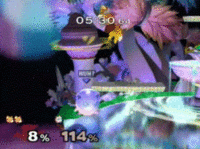Mindgame
In the Super Smash Bros. series, mindgames are strategies or techniques employed for the purpose of outwitting opponents psychologically. Alongside technical skills, mindgames constitute players' play-styles, and are considered to be an important counterpart of technical skill in competitive play.
Examples
The following are types of mindgames that have been used, described and defined by the Smash community.
Predicting

The technique of predicting is perhaps the most basic example of a mindgame. It involves observing an opponent's behaviour and discerning habitual patterns in their play-style, then predicting these actions and punishing them. Successfully predicting a player is known as a read; a "soft read" may be predicting an edge recovery once the animation begins but before it can be seen which option was chosen, while a "hard read" may be predicting an opponent's rolling direction before they tech, or even a successful prediction of their entire recovery. For instance, suppose a Melee player notices during a match that their opponent always uses a ledge attack when recovering from the ledge. The next time the opponent grabs a ledge, the player can predict the ledge attack, shield it, and punish them with an attack or grab (or avoid the ledge attack's range if the player has a reliable move with high range).
Baiting
Another example of a mindgame is baiting, also known as luring, which is a slightly more complex form of predicting and punishing. It involves tricking an opponent into putting themselves in a vulnerable position. This is done by recognising and remembering an opponent's reaction to particular a situation, and inducing that situation in order to punish their reaction. For instance, suppose a Brawl player notices that their opponent, a Toon Link player, always uses their down aerial when returning to the stage from the air, when being juggled, or when knocked high. The player can then attempt to steer their opponent into the air so that the opponent uses Toon Link's down aerial, which they will dodge, and punish during the move's ending lag.
Pressuring
Pressuring is the act of limiting an opponent's options in order to force them to react. For example, a Brawl Falco player can situate Falco at one end of a flat stage, such as Final Destination, and short hop double laser at their opponent, Snake. This severely limits Snake's ability to stand, pull grenades, plant explosives or approach from the ground without getting damaged and suffering hitstun. Snake is then forced to act in order to prevent himself from being damaged by the lasers. He must leave the stage, jump into the air or onto a platform, shield, perfect shield, crouch or crawl under them, and many of these actions leave him susceptible to further attack or manipulation by Falco.
Having difficulty dealing with pressure is a pretty big weakness for some characters, such as Yoshi, whose extremely limited OoS options and lack of reliable approach moves with considerable range gives him trouble against characters who can easily shield pressure him, and characters who can easily outrange his approaches (such as Kirby using his up tilt in Smash 64).
Spacing
Spacing is the technique of manipulating an opponent's position by utilising the range of one's character's moves relative to the range of the opposing character's moves.